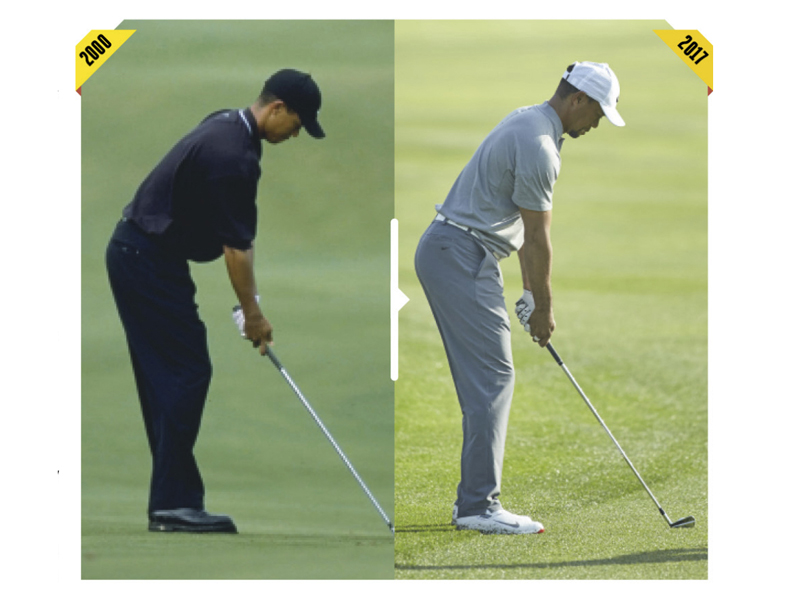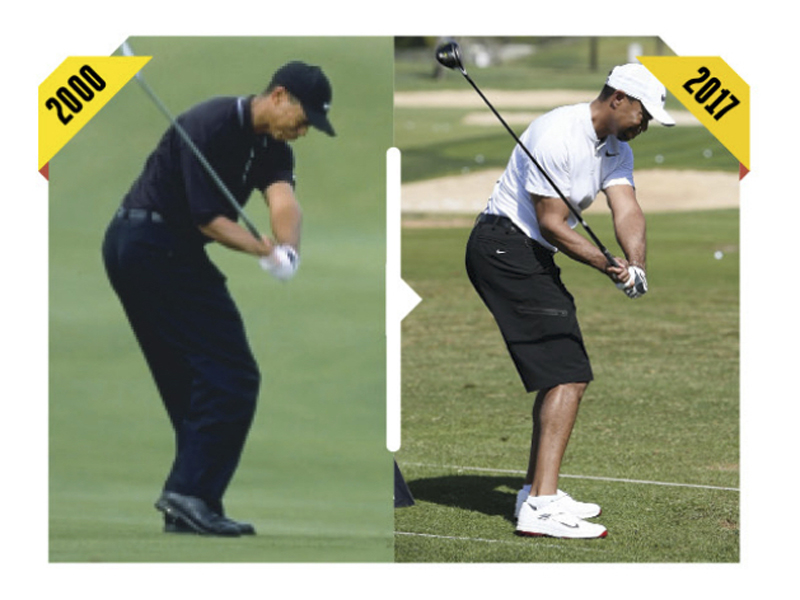How Tiger's Swing Has Changed


A catalogue of injuries have forced Tiger Woods to evolve his technique over time. Golf Monthly Top 25 Coach Dougie Bell looks at how Tiger's swing has changed from his peak in 2000 through the injury troubles to his return today
In this special instruction piece, we recruited the help of Golf Monthly Top 25 Coach Dougie Bell to look at how Tiger's swing has changed over the years. By taking a selection of still images from the year 2000, when Tiger was arguably at the pinnacle of his powers and comparing them with photos taken earlier this year at the Dubai Desert Classic, we wanted to see exactly what changes the back injuries have forced him to make and how they are affecting his game on the course. Here is how Tiger's swing has changed...

Address
Tiger Woods has always had exemplary fundamentals and little has changed in that department over the years. He has a solid base and a neutral grip, learned as a young kid working with his dad.
His posture is also perfect as he tilts from the hips with a light knee flex and his body is parallel to the target line. There is however, a crucial difference between 2000 and today - his arms hung further away from his body earlier in his career. This enabled him to create the width in the backswing that became his trademark. Crucially it also meant there was more shoulder tilt than we see in 2017 (this is perhaps a way of protecting his back) and this small but important adjustment, as you’ll see, immediately affects the plane of his swing. The other major difference between his address of 2000 versus now is how noticeable his changing body shape is. He is now bigger, bulkier and as result he looks a little less relaxed.
Subscribe to the Golf Monthly newsletter to stay up to date with all the latest tour news, equipment news, reviews, head-to-heads and buyer’s guides from our team of experienced experts.
Takeaway
Firstly, you will notice how Tiger's swing has changed because the angle of the shaft has changed here. He is standing closer to the ball now and as a result the club is working on a much steeper plane in the backswing. He also doesn’t have the incredible width he used to create (the gap between the clubhead and his sternum in the backswing is not so big). His 2000 swing is undoubtedly that of a young man keen on giving the ball a good rip.
How takeaway and swing path are linked
The other thing to notice is how in 2000, as the arms lift they remain in front of the body. It’s hard to really see it in these photographs but now his arms are slightly behind his body – you will see the effects of this as he comes in towards impact.

Top of Backswing
The key element to compare here is his hip movement - let me explain. The basic principle is that at the top of the backswing you need resistance. That means you need your upper body to turn more than your lower body. The difference in the angle of your torso versus that of your hips is what creates a lot of power in the downswing – this is resistance. But, and this is crucial, you still need a reasonable amount of hip turn in order to create the full upper body rotation you are looking for. It’s a balancing act. It is quite hard to tell from these photos but in 2000, Tiger’s hips rotated much further than they do today. This facilitated a bigger upper body rotation and made his swing one of the most powerful on Tour. Now his hip rotation is noticeably restricted and as such the swing is shorter. More importantly, when you watch it in motion his 2017 swing has a lot less flow and freedom about it. This is down to the mobility of his body.
How To Get More Distance - Power Tips for Golf

Downswing
When Tiger was at his best his transition was both smooth and powerful. Half way through the downswing, his arms were out in front of his body and this meant the club was moving on a great, neutral, path – this is one of the reasons he was so good at shaping his shots.
Now the transition is less much less smooth – it looks as if he is jumping at the ball from the top (possibly because he is worried about where the ball is going!). Importantly as the swing starts down there is a lowering of the body and a forward thrust of the hips. His hips move forwards and they do not rotate as fast as they used to. Notice how, in his 2017 swing, his hips are square to the target whereas in 2000, by this point in the swing they had almost rotated far enough to face the target. This relative lack of mobility is a sure sign that he is trying to save his back.

Impact
It is through impact where the effects of the subtle differences at address and the changes to the swing itself become most clearly visible. The extra rotation in the backswing gave him more speed through the hitting area but crucially, in 2000 there was a better connection between his arms and body. This gave him both power and accuracy. When looking at how Tiger's swing has changed it is clear that his body outruns his arms. This causes the club trail behind the body on the way down so his arms must play catch up through the strike and the results become a lot less predictable. What’s more, as you can clearly see, his spine angle lifts a fraction now and as a result of these two factors there is a much bigger reliance on timing through impact in 2017 than there was in 2000.

Finish position
In his heyday, Tiger’s finish position was one of his trademark moves and a great one for any golfer to emulate. Again, notice how Tiger's swing has changed - his spine angle has become more upright. As we have seen throughout his swing this is a sign of the protection he is affording his back. Just as importantly is the flow into the finish which was much better in 2000. Where he was once flowing and rhythmical he is now, shorter, faster and less in control.
How Tiger's Swing Has Changed: The Big Question
The question the golfing public asks each time Tiger makes another come back is, can he be the player he was in 2000? The simple answer is no. Now 41, with two children and at a different stage in his life, the goalposts have shifted - like the rest of us he can't go back in time. The power days are gone and 41-year olds don't out-muscle 20-somethings. Only Tiger truthfully knows the extent of the physical limitations that have forced him to remodel his swing but he can't be the bomber of the ball he once was. The body will not cope, not only with the pressure of going so hard at the ball but more importantly the hours on the range needed to play the game that way.
There is however, more than one way to compile a good score. If he can find a shot, an open set-up slider that he works off the left rough to get the ball in play then he is in the fight. Even if he only finds part of his former approach play and the short stuff behaves, he has a chance of winning again. After all, this is Tiger Woods.
So regarding how Tiger's swing has changed this is the big question - is he willing to change his playing style to adapt to the shorter more conservative hitting he needs? Great players in all sports have to change to survive, whether Tiger can accept this once he is fit will be the defining factor. Many of you reading this will know exactly how it feels to see your ball striking diminish over time. Remaining competitive as your body changes requires a clever gameplan and a different mindset. This sort of change is easy in theory but much harder in practice.
For his part, Tiger should remember that at his peak, his A, B or C game were all good enough to win. If the long game wasn't firing he could win with his short game. No player has had as many ways to win as he did in his prime. There was not a shot he could not hit; high, low, left, right, he could win on the links of St Andrews in a gale or the lush fairways of Augusta with the sun on his back. He cold dominate and intimate like no other. We will soon see if there is some that old fight left.

Locations: Down Royal Park Golf Club, Greenlife Golf & Kellys Golf Centre
Teaching philosophy:
My role as a coach is fairly simple: to help people hit more good shots and lower their scores. With my knowledge and experience, I can help each golfer based on their desire and experience find their own pathway. Sometimes this will be traditional technical improvements, such as set-up and swing technique. However, it will often to lead all other areas, such as strength and conditioning, mental practice, statistics and strategy.
Students learn best when:
They are able to learn by doing - as opposed to me telling the student how to move their body, or how best to place the club in a position. Through setting certain challenges, they can take ownership of the club and learn how it affects the ball. Often, allowing the player to overdo the mistake and then going to the opposite movement, helps the student to create their own feels. Just like learning to ride a bike, you need to wobble left and right first before you can find the balance point in the middle.
Advice for practice:
Measure how far you hit the ball on the course, not the range. Modern technology and driving ranges are great for practicing when time is limited, but, when possible, get out on the course with two or three balls and set some specific challenges.